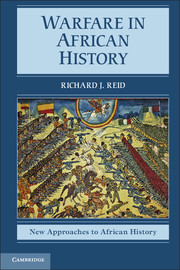Book contents
- Frontmatter
- Contents
- Maps
- Preface
- Acknowledgements
- List of maps
- Chapter 1 The Contours of Violence
- Chapter 2 Arms in Africa’s Antiquity
- Chapter 3 The Military Foundations of State and Society, to circa 1600
- Chapter 4 Destruction and Construction, circa 1600 to circa 1800
- Chapter 5 Transformations in Violence
- Chapter 6 Revolutions Incomplete
- Index
- References
Chapter 4 - Destruction and Construction, circa 1600 to circa 1800
Published online by Cambridge University Press: 05 June 2012
- Frontmatter
- Contents
- Maps
- Preface
- Acknowledgements
- List of maps
- Chapter 1 The Contours of Violence
- Chapter 2 Arms in Africa’s Antiquity
- Chapter 3 The Military Foundations of State and Society, to circa 1600
- Chapter 4 Destruction and Construction, circa 1600 to circa 1800
- Chapter 5 Transformations in Violence
- Chapter 6 Revolutions Incomplete
- Index
- References
Summary
Merchant and Military in Atlantic Africa: The Slaving State
As the external demand for slaves increased in the seventeenth and eighteenth centuries, vast areas of Atlantic Africa – including both shoreline communities and those across several hundred miles of hinterland – became militarised zones. The scale of warfare increased, and war itself became an extension of polity and economy; militarism became a matter of cultural celebration within many communities from the southern fringes of the Sahara to the northern edge of the Kalahari. Asserting the correlation between the slave trade and organised violence is hardly controversial; what is of interest here, however, is the manner in which warfare changed in this period, and how both construction and destruction resulted, in political and economic terms. Inevitably the impact and intensity of the trade varied from area to area: Whereas Senegambia and Angola had been mainstays of slave supplies for Europeans since the mid-sixteenth century, new regions opened up in the seventeenth century, notably the Slave Coast (southwest Nigeria and Benin) and the neighbouring Gold Coast on the Gulf of Guinea. This stretch of shoreline, some 400 miles long, became home to a series of forts – more or less permanent European settlements – from the mid-seventeenth century, tapping into the veritable flood of slaves brought about by the rise of such states as Dahomey, Oyo and Asante. It was a circular process, not to say a matter of chicken-and-egg: While such states arose at least partly in response to the slave trade, the presence of Dutch, English, French and Danish traders on the coast – themselves responding to ready supplies – encouraged further slave trading (and raiding) to go on, which in turn encouraged more buyers to cluster at the coast. Thus the militarisation of African society and economy was a cumulative process, and involved the emergence of what has become known as the ‘slaving state’.
- Type
- Chapter
- Information
- Warfare in African History , pp. 79 - 106Publisher: Cambridge University PressPrint publication year: 2012



